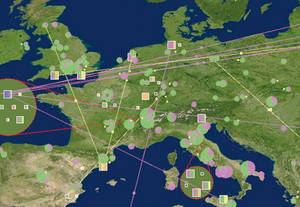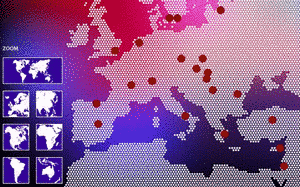EGEE Project
Results
Funded by the European Commission, the Enabling Grids for E-sciencE (EGEE) project is the flagship Grid infrastructure project of the EU. The third two-year phase of the project started on 1 May 2008 and includes:
- A Grid infrastructure spanning about 250 sites across 50 countries
- An infrastructure of more than 68,000 CPU available to users 24 hours a day, 7 days a week,
- More than 20 Petabytes (20 million Gigabytes) of storage.
- Sustained & regular workloads of 150K jobs/day, reaching up to 188K jobs/day
- Massive data transfers > 1.5 GB/s
- User Support including:
-A single access point for support, a portal with well structured information and updated documentation;
-knowledgeable experts;
-correct, complete and responsive support;
-tools to help resolve problems.
- Security & Policy, including:
-Authentication (Use of GSI, X.509 certificates generally issued by national certification authorities)
-Agreed network of trust (International Grid Trust Federation (IGTF), EUGridPMA, APGridPMA, TAGPMA)
-All EGEE sites will usually trust all IGTF root CAs
EGEE in real time
Want to see the power of the EGEE infrastructure? Then download the Real Time Monitor to your PC and watch the grid in action!

GridPP's Real Time Monitor displays a 'map' of the grid, showing running and scheduled jobs in near real time. You can download the 3D version at http://gridportal.hep.ph.ic.ac.uk/rtm/. A 2D version is available from http://gridportal-ws01.hep.ph.ic.ac.uk/rtm_2D_2008/applet.html.
You can also see the Monitoring Frameworks through the Grid Operations Centre GIIS Monitor.
EGEE Applications
EGEE supports applications from many scientific domains, such as astrophysics, biomedicine, computational chemistry, earth sciences, high energy physics, finance, fusion, geophysics and multimedia. In addition, there are several applications from business sectors running on the EGEE Grid, such as applications from geophysics and the plastics industry.
GridGuide
Launched in March 2009, the GridGuide from GridTalk shows the human face of grid computing. The GridGuide website encourages visitors to explore an interactive map of the world, visiting a sample of the thousands of scientific institutes involved in grid computing projects.

Sites from more than 20 countries appear on the GridGuide, offering insider snippets on everything from research goals and grid projects to the best place to eat lunch and the pros and cons of working in grid computing.


